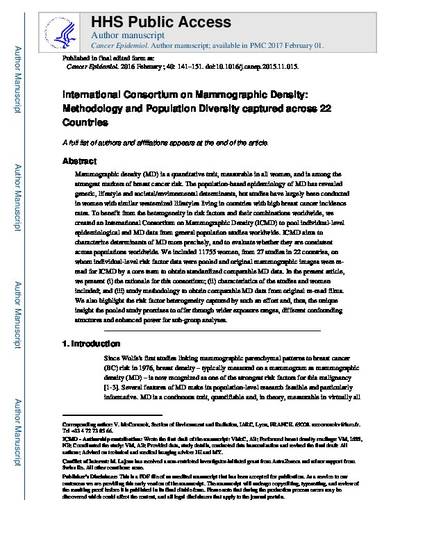
Article
International Consortium on Mammographic Density: Methodology and population diversity captured across 22 countries
Cancer Epidemiology
Publication Date
1-1-2016
Document Type
Article
Disciplines
Abstract
Mammographic density (MD) is a quantitative trait, measurable in all women, and is among the strongest markers of breast cancer risk. The population-based epidemiology of MD has revealed genetic, lifestyle and societal/environmental determinants, but studies have largely been conducted in women with similar westernized lifestyles living in countries with high breast cancer incidence rates. To benefit from the heterogeneity in risk factors and their combinations worldwide, we created an International Consortium on Mammographic Density (ICMD) to pool individual-level epidemiological and MD data from general population studies worldwide. ICMD aims to characterize determinants of MD more precisely, and to evaluate whether they are consistent across populations worldwide. We included 11755 women, from 27 studies in 22 countries, on whom individual-level risk factor data were pooled and original mammographic images were re-read for ICMD to obtain standardized comparable MD data. In the present article, we present (i) the rationale for this consortium; (ii) characteristics of the studies and women included; and (iii) study methodology to obtain comparable MD data from original re-read films. We also highlightthe risk factor heterogeneity captured by such an effort and, thus,the unique insightthe pooled study promises to offer through wider exposure ranges, different confounding structures and enhanced power for sub-group analyses.
Citation Information
Valerie A. McCormacka, Anya Burton, Isabel dos-Santos-Silva, John H. Hipwell, et al.. "International Consortium on Mammographic Density: Methodology and population diversity captured across 22 countries" Cancer Epidemiology Vol. 40 (2016) p. 141 - 151 Available at: http://works.bepress.com/m-chiarelli/9/